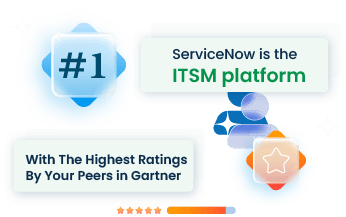“Managing business performance often involves navigating a maze of fragmented data and unclear metrics. For many, this can result in missed opportunities and inefficiencies. ServiceNow Performance Analytics steps in to address these challenges by providing clear, actionable insights.
This tool transforms raw data into meaningful information, allowing for better decision-making and resource allocation. By focusing on critical metrics and trends, ServiceNow Performance Analytics enables you to align operations with business goals seamlessly. Reading this article will equip you with the knowledge to harness this tool effectively, turning complex data into strategic advantages.
What is ServiceNow Performance Analytics?
ServiceNow Performance Analytics serves as a powerful tool for tracking, analyzing, and visualizing key performance indicators (KPIs) within your business processes. This tool provides actionable insights by collecting data over time, allowing you to identify trends, predict outcomes, and make informed decisions.
Its purpose lies in optimizing business performance by offering a clear view of your organization’s operations. This enables better resource allocation, improved service delivery, and alignment with strategic goals. With interactive dashboards, scorecards, and robust reporting capabilities, ServiceNow Performance Analytics empowers you to stay ahead in a competitive landscape.
Key Features of ServiceNow Performance Analytics
Indicator
Indicators serve as the foundation for tracking performance metrics. They pinpoint critical data points such as incident resolution times, customer satisfaction scores, or system uptime. In an IT service desk, tracking the average resolution time of tickets can help pinpoint areas needing improvement.
Breakdown
Breakdowns provide detailed views of indicators by splitting data into smaller segments. This allows for a more granular analysis. In a customer support scenario, breakdowns can segment data by region, product, or support tier, enabling a closer look at performance variations across different segments.
Data Collector
Dashboards consolidate various widgets and data points into a single, user-friendly interface. They offer a comprehensive view of performance metrics at a glance. Executives in a corporation might use dashboards to review key performance indicators (KPIs) across departments, facilitating informed decision-making.
Widget
Widgets visualize data on dashboards, making complex data more accessible. They can display metrics through graphs, charts, or gauges. A sales team might use widgets to visualize monthly sales figures, helping them to identify trends and adjust strategies promptly.
Dashboard
Widgets visualize data on dashboards, making complex data more accessible. They can display metrics through graphs, charts, or gauges. A sales team might use widgets to visualize monthly sales figures, helping them to identify trends and adjust strategies promptly.
Text Analytics
Text Analytics processes unstructured data, such as customer feedback or incident reports, to extract valuable insights. In a customer service department, analyzing support tickets’ text can reveal common issues or trends, helping to improve service quality.
Scorecards
Scorecards compare performance against targets, offering a clear view of how well goals are being met. A marketing team might use scorecards to track campaign performance against objectives, adjusting tactics as needed to meet targets.
Interactive Dashboards
Interactive Dashboards allow users to drill down into data for deeper insights. They provide a dynamic way to explore data and uncover trends. If a financial analyst might use interactive dashboards to delve into expense reports, identifying areas where costs can be cut.
Interactive Dashboards allow users to drill down into data for deeper insights. They provide a dynamic way to explore data and uncover trends. If a financial analyst might use interactive dashboards to delve into expense reports, identifying areas where costs can be cut.
The Analytics Hub centralizes data and analytics tools, providing a single access point for comprehensive data analysis. It supports various analytics processes and integrates seamlessly with other tools. The HR manager might use the Analytics Hub to monitor employee performance metrics and make data-driven HR decisions.
Out-of-the-box KPIs
ServiceNow offers pre-built KPIs that can be used immediately, saving time on setup. These KPIs cover common business metrics, ensuring that essential data is tracked from the start. A project manager might use out-of-the-box KPIs to track project timelines and resource allocation without needing extensive configuration.
Benefits of Using ServiceNow Performance Analytics
Improved Decision Making ServiceNow Performance Analytics provides real-time insights, allowing you to track and measure key performance indicators (KPIs). With access to accurate data, you can make informed choices that align with your business goals. This tool transforms raw data into actionable insights, guiding you through complex decision-making processes.
Enhanced Resource Utilization By analyzing data trends, ServiceNow Performance Analytics helps you allocate resources where they are needed most. This ensures that your team works on the most impactful tasks, reducing waste and increasing productivity. You gain a clear view of resource allocation, enabling better management of both human and material resources.
Predicting Trends and Identifying Potential Problems ServiceNow Performance Analytics excels at trend analysis, giving you the ability to anticipate future challenges. By monitoring historical data, you can identify patterns that suggest potential issues, allowing you to address them before they escalate. This proactive approach reduces downtime and enhances overall service quality.
Aligning Service Objectives with Business Goals Aligning your service objectives with overarching business goals is crucial for long-term success. ServiceNow Performance Analytics bridges the gap between IT and business strategies by providing insights that ensure your services support your organizational objectives. This alignment fosters a cohesive strategy across departments.
Continual Service Delivery Enhancement Continuous improvement in service delivery becomes achievable with ServiceNow Performance Analytics. By regularly reviewing performance data, you can identify areas for improvement and implement changes. This ongoing refinement process leads to better service quality and customer satisfaction.
Building an Analytics Culture Cultivating an analytics-driven culture within your organization encourages data-driven decisions at all levels. ServiceNow Performance Analytics promotes a mindset where every team member values and utilizes data insights. This shift towards an analytical approach results in more strategic initiatives and improved operational outcomes.
How to Get Started?
Performance Analytics within ServiceNow empowers you to make informed decisions by providing insights into your data. Let’s walk through the process of setting it up and customizing it to meet your business needs.
Step-by-Step Guide to Setting Up Performance Analytics
1. Accessing Performance Analytics
- Navigate to your ServiceNow instance.
- In the Application Navigator, type Performance Analytics and select it from the list.
2.Initial Configuration
- Activate Plugins: Ensure the Performance Analytics – Content Pack and other relevant plugins are active.
- Indicator Source Configuration: Set up the data sources. These will feed data into your indicators.
- Define Indicators: Create indicators that reflect key metrics for your business.
- Breakdowns: Establish breakdowns to segment your data, such as by department or region.
- Data Collector Jobs: Schedule data collection to ensure indicators receive updated data regularly.
3.Dashboard Creation
- Widgets: Add widgets to your dashboards to visualize data.
- Layout: Arrange widgets in a meaningful way. Consider starting with a template for ease.
How to Customize Performance Analytics to Fit Your Business Needs?
Performance Analytics can be tailored to reflect your specific requirements
- Custom Indicators: Beyond default indicators, create custom ones that track metrics unique to your organization
- Targeted Dashboards: Develop dashboards for different user roles, ensuring that each user sees data relevant to their responsibilities.
- Thresholds and Alerts: Set thresholds to monitor key metrics and configure alerts to notify stakeholders when values cross critical points.
Actionable Steps and Checklists
1. Initial Setup
- Activate necessary plugins.
- Define and configure data sources.
- Set up and test indicators and breakdowns.
- Schedule data collection jobs.
2. Ongoing Maintenance
- Review and update indicators regularly.
- Adjust dashboards to reflect new insights or changes in strategy.
- Train users on interpreting and acting on data presented in dashboards.
Best Practices for ServiceNow Performance Analytics
ServiceNow Performance Analytics can provide clear insights into your business performance when used correctly. Below are some best practices to get the most out of this powerful tool
Prioritize Resources: Focus on areas where analytics can make the most impact. Identify critical indicators that align with your business goals and allocate resources to these areas first.
Invest in Continual Service Improvement: Regularly review and refine your analytics processes. Use feedback and new data to adjust your metrics and targets, driving ongoing improvements.
Maximize Automation: Automate data collection and reporting wherever possible. This reduces manual effort and increases data accuracy, allowing your team to concentrate on analysis and decision-making.
Offer Self-Service for Improved User Experiences: Empower users by providing self-service dashboards and reports. This not only saves time for your IT team but also enhances user engagement and satisfaction.
Measure Leading and Lagging Indicators: Track both leading indicators, which predict future performance, and lagging indicators, which reflect past performance. This balanced approach gives a complete picture of your business health.
Have a Conversation with Your Data: Regularly interact with your data. Use the analytics hub to explore trends, identify anomalies, and gain insights. This practice helps in making informed decisions.
Introduce Performance Analytics in Stages: Start with a few key metrics and gradually expand your analytics scope. This phased approach allows for manageable implementation and reduces the risk of overwhelming your team.
Take Time to Explore, Improve, and Customize: Customize your analytics setup to match your unique business needs. Regularly update and improve your dashboards and reports to keep them relevant and useful.
ServiceNow Performance Analytics vs. Reporting
Differences Between Performance Analytics and Reporting
ServiceNow Performance Analytics and traditional reporting serve different purposes within your organization.
Performance Analytics focuses on real-time data tracking, providing insights through trend analysis, predictive modeling, and scorecards. This tool enables ongoing monitoring of key performance indicators (KPIs), helping you make data-driven decisions based on live data.
Reporting in ServiceNow provides historical snapshots, generating static reports from collected data. These reports summarize past performance and are useful for compliance, audits, and retrospective analysis.
When to Use Performance Analytics?
Performance Analytics proves valuable when you need to
- Monitor real-time data to make informed decisions.
- Identify trends and predict future performance.
- Use interactive dashboards for dynamic data visualization.
- Utilize scorecards for continuous KPI tracking.
When to Use Reporting?
- Require historical data for compliance and audit purposes.
- Need to generate static summaries of past performance.
- Want to review historical data for strategic planning.
- Prefer static, printable reports for documentation.
Comparison Table
| Feature | Performance Analytics | Reporting |
|---|---|---|
| Data Tracking | Real-time | Historical snapshots |
| Decision Support | Ongoing, data-driven | Retrospective analysis |
| Trend Analysis | Predictive modeling | Static summaries |
| Dashboards | Interactive | Static |
| KPI Monitoring | Continuous | Periodic |
| Use Cases | Live decision-making, trend identification | Compliance, audit, documentation |
How to Create a Performance Analytics Report in ServiceNow
Creating a Performance Analytics report in ServiceNow involves several steps, each essential for crafting a report that meets your business needs. This guide will walk you through these steps with clear, detailed instructions and tips for customization.
Step-by-Step Instructions
1. Access Performance Analytics
- Navigate to the ServiceNow dashboard.
- Locate and open the Performance Analytics application.
2. Define Your Indicators
- Go to the Indicators module.
- Click on New to create a new indicator.
- Fill in the necessary fields such as Name, Description, and Data Source.
- Set the conditions for data collection to align with your objectives.
3. Create Data Collectors
- Access the Data Collector module.
- Select New to set up a data collection job.
- Link your data collector to the indicators created earlier.
- Schedule the data collection to run at intervals that suit your reporting needs.
4. Set Up Breakdowns
- Breakdowns allow you to segment data for deeper insights.
- Navigate to the Breakdowns module.
- Create new breakdowns and associate them with your indicators.
5. Build Dashboards
- Dashboards present your data visually.
- Access the Dashboard module and click New.
- Add widgets that display your indicators and breakdowns.
- Customize the layout to highlight key metrics.
Tips for Customizing Reports
● Tailor Data Presentation
- Use widgets to present data in formats that best convey your message (e.g., charts, graphs, scorecards).
- Customize colors and layouts to align with your company’s branding and make data interpretation easier.
● Segment Data with Breakdowns
- Utilize breakdowns to filter data by different dimensions such as time, department, or region. This allows for more precise analysis.
● Set Up Automated Notifications
- Configure alerts to notify stakeholders when certain thresholds are met or anomalies detected, ensuring prompt action.
● Utilize Historical Data
- Include historical data to identify trends and patterns. This adds context to your current metrics and helps in forecasting future performance
Conclusion
Implementing ServiceNow Performance Analytics transforms business insights and decision-making processes. ServiceNow Performance Analytics provides tools that drive smarter, data-backed decisions, optimizing resource allocation, and predicting trends to prevent issues. With real-time dashboards and interactive analytics at your fingertips, strategic initiatives align seamlessly with business goals. Don’t miss out on harnessing these insights. ServiceNow consulting can guide your implementation, helping you unlock the full potential of ServiceNow Performance Analytics. Start leveraging these powerful tools for unparalleled business insights and operational excellence.













